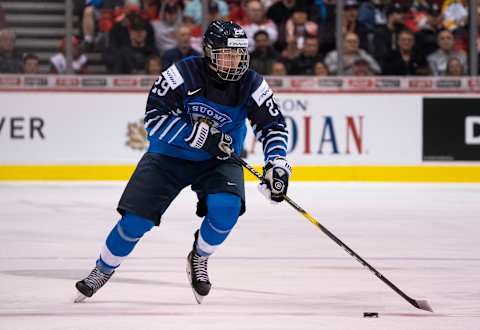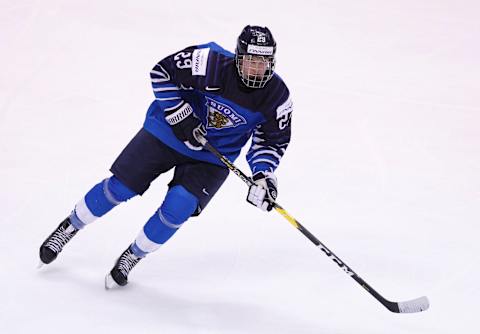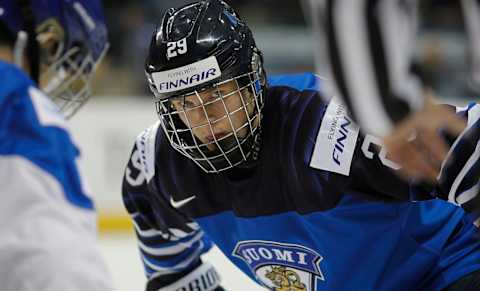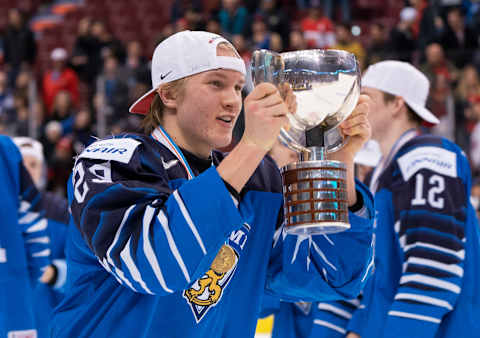2020 NHL Draft prospect profile: Anton Lundell scouting report


The 2020 NHL draft is stock-piled with high-end talent. Each week, we’ll give you at least one scouting report on all the prospects you need to know. This week, we take a look at Anton Lundell.
I’ve previously written deep-dives on 2020 NHL Draft prospects Alexis Lafreniere, Quinton Byfield, Lucas Raymond, and Cole Perfetti. Today, I will be looking at the Finnish star Anton Lundell.
Before I begin, for those that don’t know, here’s how these scouting reports go. First, I will begin with some general background information and statistics from that player. Then, I will break down the player’s tendencies, habits, and roles on special teams. Following that up, I will break down the positives and negatives in the prospects’ game. Finally, I will look at what I feel is the potential of that player, as well as his NHL-readiness.
More from Puck Prose
- Detroit Red Wings 2023 Rookie Camp Has Plenty of Ups and Downs
- This Columbus Blue Jackets rookie doesn’t want to be forgotten
- 2 trades the Boston Bruins must make to secure the Stanley Cup
- 3 reasons the Avalanche won’t win the Stanley Cup in 2024
- This is a big year for Alex Turcotte and the Los Angeles Kings
Here’s a list of our past scouting reports for 2020 draft prospects.
Background
Anton Lundell was born on October 3rd, 2001 in Espoo, Finland. He is an 18-year-old, left-handed, center and winger for HIFK in Liiga, which is Finland’s top professional league. Lundell measures in at 6’1″ and 181 pounds.
Lundell first broke onto the scene in the 2017-18 season when he broke out with 3 goals and 10 points in 10 games as a 16-year-old with HIFK’s Junior B team. This earned him a call-up to HIFK’s Junior A under-20 team. There, he recorded an additional 8 goals and 20 points in 22 games.
He played in the postseason in both leagues that year. In the Junior B League, he put up 1 goal and 4 assists (5 points) in 5 games. Meanwhile, in the Junior A League, he had 1 goal and 2 points in 9 games. Lundell also played in the World Hockey Championship with Finland’s under-17 team, recording 3 goals and 7 points in 5 games there. He capped off his age 16 season with an invitation to the World Junior Championships with Finland’s under-18 team, recording 2 goals and 6 points in 7 games.
After a very impressive season in 2017-18, Lundell followed that up with more strong play. He started the year as an assistant captain as a 17-year-old on HIFK’s Junior A under-20 team, where he put up 6 goals and 9 assists (15 points) in 10 games. He became a future elite prospect when he earned his shot at the top-level in Liiga with HIFK’s men’s team.
In his first season playing professionally in Finland, Lundell was impressive, potting 9 goals 19 points in 38 games. He played in the postseason in Liiga but failed to record a point in 12 games. Lundell also played internationally for Finland in both the under-18 and under-20 World Junior Championships. In the U-18 tournament, Lundell posted 2 goals and 4 points in 5 games. He also recorded 1 goal and 4 points in 7 games in the U-20 tournament.
This season, Lundell has played 23 games (as of Tuesday, January 14th, 2020), putting up a stat line of 6 goals and 9 assists (15 points). He was not invited to play in the 2020 World Junior Championships for Finland this time around.

Lundell’s Tendencies
To start with some of Lundell’s tendencies, let’s look at the offensive zone first. One thing that immediately jumps out to me is his shoot-first mentality. It’s a safe bet to assume that he’ll be the player shooting the puck on an odd-man rush, as he is a pure sniper.
He plays smart with the puck, as he doesn’t get too cute with the puck when it comes to stickhandling. Lundell does not force passes or shots that aren’t open to take. It helps him to limit his turnovers, which ultimately makes him a more appealing player for teams when he has the puck.
On the power play, he plays on the half-wall and point area. That tells me that the team puts him in a position to utilize his shot, putting him in a prime one-timer spot. As for the penalty kill, HIFK runs the “box” formation (two forwards play from the dots to the top of the face-off circle, staying on either the right or left) and he plays aggressively in that spot.
He possesses an active stick, meaning he utilizes his poke checks and stick lifts, and also waving his stick in front of him to rush the opponent and take away passing lanes. That active stick assists him on the penalty kill, as he rushes at the opponent with the puck and forces turnovers constantly.
One negative habit that he has, is he cheats up ice on the breakout. This happens a lot with many NHL players, but there’s one thing that I worry about. Lundell is a center more than he is a winger. As a center, generally, you’re supposed to be the last forward out of the defensive zone, as you are basically the third defenseman.
When the center cheats up ice on the breakout, that leaves the two defensemen outnumbered in their own zone. If there’s a turnover, it’s more likely than not that they will give up a dangerous scoring opportunity.

Positives and Negatives
As a skater, Lundell does not possess blazing speed. However, he is not slow by any means; he has an above-average skating ability. His acceleration is also excellent, as he reaches his top speed extremely fast. He also does not possess strong edge work, as he is not able to make sharp turns or stop on a dime. However, he is still a good skater, and if he works on the small things, like his edge work, then he has the potential to be a very good skater.
Physically, he doesn’t get involved much. But he does not shy away from physical play. He gets involved regularly in board battles, though with his size, he doesn’t always win.
Offensively, Lundell has a strong awareness of where his teammates are and can complete no-look passes, especially when entering the zone, with effectiveness. However, his movement without the puck is extremely sloppy. He never stays in a general area, as he seemingly chases the puck all over the offensive zone.
Lundell’s greatest strength is in his shot. He has an NHL-ready shot, with a sneaky good release, excellent accuracy, and incredible power. He always gets to a high-danger area to let loose a cannon of a shot.
An underrated and under-utilized aspect of Lundell’s game is his playmaking ability. He has excellent vision and makes quick and smart passes. He very rarely makes mistakes or turns the puck over, and he has the patience to allow a play to develop when given the time.
Lundell has good stickhandling and puck control, though that part of his game isn’t something to write home about. He also does an excellent job using his body to protect the puck extremely well, which will be very useful for him as he makes the jump to the NHL level.
Lundell does an excellent job forechecking. He uses his active stick to force turnovers, and his aggressiveness is at a high level, as he charges at the opposition while using the aforementioned active stick. He doesn’t shine on the backcheck, however, though he isn’t too bad in that area either.
In the defensive zone, he’s solid but definitely needs improvement. His positioning, for example, needs a lot of work. The disorganized positioning in the offensive zone is apparent in the d-zone as well. Outside of that, however, he does a nice job in the corners and supports the defense down low.
Again, his active stick provides a bonus, as he’s able to break up passes and get into shooting lanes. Lundell’s defensive game is extremely raw, but he has the foundation to, at the very least, be trusted in his own end when needed. When playing on the wing, like when he’s on the penalty kill, he does a magnificent job attacking the point area.

Potential, NHL Comparison, and NHL Readiness
Lundell, like with most of the prospects in this draft, has elite potential. He possesses high-end skills on both ends of the ice that can become solid over time. However, the style he plays is very exuberant. The high-energy and sloppy play makes me question how safe he is to select early.
I have concerns that if he does not improve upon his positioning and edge work, and his defensive zone play remains lackluster, then he could be the next big bust. However, odds are he turns out just fine, and at the very least becoming a middle-six center, with powerplay capabilities.
My concern for Lundell is his NHL-readiness. He is at least two or three years away from being an NHL player if he develops smoothly. However, compared to surrounding prospects, he’s a little further out. That said, an NHL team that drafts Lundell and watches other prospects taken before and after their selection flourish in the NHL before Lundell can adapt, they could grow impatient and thrust him into a role he isn’t ready for. That alone could kill a prospect’s development quickly.
Finally, let’s look at some comparables. Lundell reminds me of a slower version of Brayden Point. The reason I say this is because Point possesses an incredible shot and under-utilized playmaking abilities, while also being reliable in his own end.
Next. Every Team's Mount Rushmore. dark
If Lundell could develop his skating further, as well as his overall defensive game, he could be Brayden Point 2.0. However, that’s an unfair comparison to have at this moment, but it’s safe to say that he plays a very similar style with very similar skill sets.